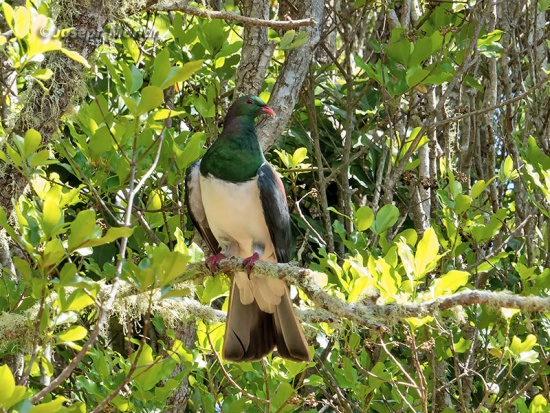Includes Norfolk Island Pigeon
- Hemiphaga novaeseelandiae
Identification
46–50 cm (18-19¾ in)
- Head, throat, upper breast and upperparts metallic green with a purplish sheen and bronze tints especially around neck, or an ashy-grey wash. White lower breast, belly and legs with a sharp line between the green upper area and the white below.
- Broad rounded wings and a long wide tail
- Red bill with orange tip, crimson eyes and feet.
Juveniles are similar, but upperparts are duller with a smudgy upper breast; dull feet and bill, and usually a shorter tail.
Distribution
Taxonomy
Two subspecies are recognized.
- H. n. spadicea (Norfolk Island Pigeon) -- Formerly Norfolk Island, Extinct
- H. n. novaeseelandiae -- Forests of New Zealand and larger offshore islands
Chatham Island Pigeon is sometimes included in this species.
Habitat
Native forests, forest adjacent to agricultural land, scrub, rural and city gardens and parks.
Behaviour
Action
Strong steady wing beats in flight, giving a distinctive, noisy swish.
Diet
Their diet consists mostly of ripe fruits. They also eat leaves, shoots, flowers, buds, nectar and sap.
Breeding
They are long-lived birds, and breed very slowly. Key breeding signals are spectacular diving display flights performed mainly by territorial males. They nest mainly in spring/early summer producing only one egg which parents take turns to look after during the 28-day incubation period. In the first week after hatching, the fluffy chick is fed "pigeon milk", a protein-rich milky secretion from the walls of the parents' crops, mixed with fruit pulp. A week later the chick is ready for regurgitated berries. North Island chicks fledge at four to five weeks while the South Island chicks take two weeks longer. The fledglings then spend another week with their parents before becoming fully independent.
Vocalisation
Call: is a single kuu, which is soft and pentrating.
References
- Clements, J. F., T. S. Schulenberg, M. J. Iliff, S. M. Billerman, T. A. Fredericks, B. L. Sullivan, and C. L. Wood. 2019. The eBird/Clements Checklist of Birds of the World: v2019. Downloaded from http://www.birds.cornell.edu/clementschecklist/download/
- Baptista, L.F., Trail, P.W., Horblit, H.M., Kirwan, G.M. & Garcia, E.F.J. (2017). New Zealand Pigeon (Hemiphaga novaeseelandiae). In: del Hoyo, J., Elliott, A., Sargatal, J., Christie, D.A. & de Juana, E. (eds.). Handbook of the Birds of the World Alive. Lynx Edicions, Barcelona. (retrieved from http://www.hbw.com/node/54402 on 12 March 2017)
- BirdLife International. 2016. Hemiphaga novaeseelandiae. The IUCN Red List of Threatened Species 2016: e.T22727557A94952579. http://dx.doi.org/10.2305/IUCN.UK.2016-3.RLTS.T22727557A94952579.en. Downloaded on 12 March 2017.
- Goldberg, J., Trewick, S.A. & Powlesland, R.G. (2010) Population structure and biogeography of Hemiphaga pigeons (Aves: Columbidae) on islands in the New Zealand region. J. Biogeogr. 38(2): 285-298.
- Higgins, P.J.; Davies, S.J.J.F. (Eds.) 1996. Handbook of Australian, New Zealand and Antarctic birds. Vol. 3, snipe to pigeons. Oxford University Press, Melbourne.
- Millener, P.R. & R.G. Powlesland, 2001. The Chatham Islands pigeon (Parea) deserves full species status; Hemiphaga chathamensis (Rothschild 1891); Aves: Columbidae. Journal of the Royal Society of New Zealand, 31:365-383. PDF
- Powlesland, R.G. 2013. New Zealand pigeon. In Miskelly, C.M. (ed.) New Zealand Birds Online. http://www.nzbirdsonline.org.nz
- BirdForum Member observations
Recommended Citation
- BirdForum Opus contributors. (2024) New Zealand Pigeon. In: BirdForum, the forum for wild birds and birding. Retrieved 14 May 2024 from https://www.birdforum.net/opus/New_Zealand_Pigeon
External Links
GSearch checked for 2020 platform.1






